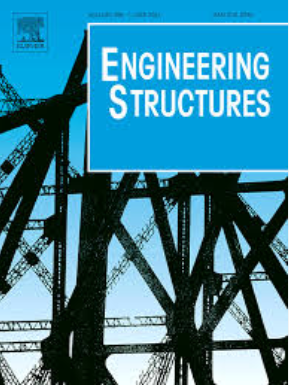Machine learning-driven prediction of axial capacity of concrete-filled steel tubes columns with built-in bamboo or timber cores
IF 6.4
1区 工程技术
Q1 ENGINEERING, CIVIL
引用次数: 0
Abstract
Studies on concrete-filled steel tube columns with built-in bamboo or timber cores (CFST-BTC) not only optimize the mechanical properties of conventional concrete-filled steel tube (CFST) columns but also reduce concrete usage and carbon emissions, enhancing structural sustainability. This study establishes a CFST-BTC database of 271 specimens under axial compression and evaluates various machine learning (ML) models for predicting their ultimate bearing capacity (Ncu). Six mainstream ML algorithms such as ANN, LightGBM, Gradient Boosting Regressor, CatBoost, XGBoost and AdaBoost were assessed for training and predicting Ncu of CFST-BTC. Gradient Boosting Regressor and ANN effectively predicted the experimental results, achieving R² values of 0.9988/0.9985 for the training set and 0.9964/0.9959 for the test set, significantly outperforming traditional analytical models. Based on SHAP analysis, key parameters were identified, nonlinear relationships were revealed, and the user-friendly analytical equation was formulated based on ANN. The proposed equation demonstrated strong predictive performance, achieving an R² value of 0.9609 and an RMSE of 156.35. Although these results are slightly inferior to those of the six ML surrogate models, they surpass the explicit equation constructed using multiplication (R² = 0.9297) and other traditional analytical models. The user-friendly equation suggests that the optimal substitution ratio (w) of bamboo or timber core replacing the core concrete in CFST-BTC is 36.5 %, providing guidance for the practical application of CFST-BTC columns in engineering. Meanwhile, the suggested explicit equation effectively satisfies the boundary conditions at w = 0 and w = 1, ensuring reliable predictions for ultimate bearing capacity of both CFST columns and bamboo or timber-filled steel tube (BTFST) columns without computational inconsistencies at the boundary conditions.
机器学习驱动的内置竹芯或木芯钢管混凝土柱轴向承载力预测
竹木内嵌芯钢管混凝土柱(CFST- btc)的研究不仅优化了传统钢管混凝土柱的力学性能,而且减少了混凝土的使用和碳排放,提高了结构的可持续性。本研究建立了271个轴压下的CFST-BTC数据库,并评估了各种机器学习(ML)模型对其极限承载力(Ncu)的预测效果。研究了ANN、LightGBM、Gradient Boosting Regressor、CatBoost、XGBoost和AdaBoost等6种主流ML算法对CFST-BTC Ncu的训练和预测效果。Gradient Boosting Regressor和ANN有效地预测了实验结果,训练集的R²值为0.9988/0.9985,测试集的R²值为0.9964/0.9959,显著优于传统的分析模型。基于SHAP分析,识别关键参数,揭示非线性关系,建立基于人工神经网络的人性化分析方程。该方程具有较强的预测性能,R²值为0.9609,RMSE为156.35。虽然这些结果略逊于六个ML代理模型,但它们优于使用乘法(R²= 0.9297)构建的显式方程和其他传统分析模型。用户友好型方程表明,竹芯或木芯替代CFST-BTC核心混凝土的最佳替代率(w)为36.5% %,为CFST-BTC柱在工程中的实际应用提供了指导。同时,所提出的显式方程有效地满足了w = 0和w = 1的边界条件,保证了CFST和竹木钢管(BTFST)柱极限承载力的可靠预测,在边界条件下没有计算不一致的情况。
本文章由计算机程序翻译,如有差异,请以英文原文为准。
求助全文
约1分钟内获得全文
求助全文
来源期刊

Engineering Structures
工程技术-工程:土木
CiteScore
10.20
自引率
14.50%
发文量
1385
审稿时长
67 days
期刊介绍:
Engineering Structures provides a forum for a broad blend of scientific and technical papers to reflect the evolving needs of the structural engineering and structural mechanics communities. Particularly welcome are contributions dealing with applications of structural engineering and mechanics principles in all areas of technology. The journal aspires to a broad and integrated coverage of the effects of dynamic loadings and of the modelling techniques whereby the structural response to these loadings may be computed.
The scope of Engineering Structures encompasses, but is not restricted to, the following areas: infrastructure engineering; earthquake engineering; structure-fluid-soil interaction; wind engineering; fire engineering; blast engineering; structural reliability/stability; life assessment/integrity; structural health monitoring; multi-hazard engineering; structural dynamics; optimization; expert systems; experimental modelling; performance-based design; multiscale analysis; value engineering.
Topics of interest include: tall buildings; innovative structures; environmentally responsive structures; bridges; stadiums; commercial and public buildings; transmission towers; television and telecommunication masts; foldable structures; cooling towers; plates and shells; suspension structures; protective structures; smart structures; nuclear reactors; dams; pressure vessels; pipelines; tunnels.
Engineering Structures also publishes review articles, short communications and discussions, book reviews, and a diary on international events related to any aspect of structural engineering.
 求助内容:
求助内容: 应助结果提醒方式:
应助结果提醒方式:


